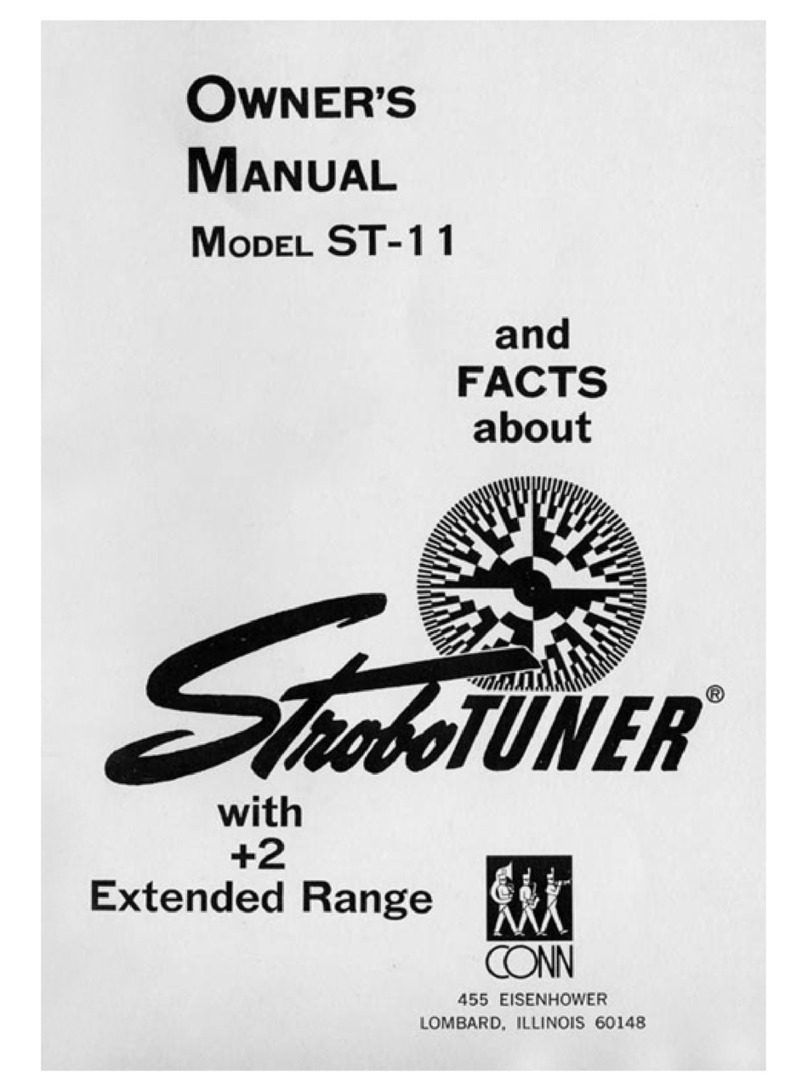
STROBOCONN "PIANO TUNING" MANUAL
CAUTION:
The
Stroboconn is designed to operate
on
apower source supplying 105-120 volts, 50-60 cycle
alternating current. Connection
to
improper
power
source may cause damage
to
the instrument.
If
operation
on
direct current is required, aconverter must be used.
FOR
OPERATION
ON
LOW
LINE
VOLTAGE:
The
6T-3 Stroboconn is equipped with aline voltage
switch to provide normal
motor
drive power
under
conditions
of
low
power line voltage.
The
NORMAL
position is recommended
for
all occasions
of
use except
when the power line voltage is
so
low
that
the scanning
unit
motor
will
not
drive the discs synchronously. This
condition will be evidenced by the blinking
of
the
motor
pilot
light
or
by oscillation
of
the observed
stroboscopic pattern.
CAUTION:
Operating
the Strobo-
conn with the switch
in
the
LOW
line voltage position
on
normal line voltage, however, will subject
the
tubes
and
electrical components
to
undue strain, possibly
shortening their lives
and
causing failure
of
the instru-
ment.
HOW
TO START
THE
STROBOCONN
To
turn
on, first
lift
the
No.1
or
"Power"
switch
at
the extreme
right
hand
end
of
the scanning
unit
to
the
ON
position.
No.
2switch should be pushed down
to the
WARM-UP
position,
and
about forty seconds
allowed
for
the vacuum tubes to warm up.
(This
allows
the fork
to
build
up
its vibration sufficiently
to
drive the
motor,
and
will be shown by the
MOTOR
PILOT
light
in
the center
of
the scanning
unit
glowing stea.dily.)
The
No.2
switch
at
the
right
side
of
the scanning
unit
should
now
be lifted to the
RUN
position.
This
trans-
fers the power from the
motor
to the
fork
drive
and
turns
on
the Microphone Amplifier, which takes about
twenty seconds
to
heat
up. Sound reaching the micro-
phone should then cause the windows in the mask to be
illuminated.
If
the
MOTOR
PILOT
light
does
not
glow
steadily,
but
blinks after the
No.2
switch has been lifted,
the fork has
not
been allowed sufficient time to build
up
its vibration,
and
the
No.2
switch should be pressed
down and alittle more time allowed.
When
the above operations have been performed the
Stroboconn is ready
for
use.
(Refer
to
Fig. 2
for
identification
of
Parts
mentioned.)
READING
THE
STROBOCONN
With
the Stroboconn the frequency
of
any tone lying
within the essential range
of
the piano keyboard may be
determined directly.
The
method is entirely visual
and
does
not
involve the sounding
of
any comparison tone.
Deviations are measured from the tones
of
the equally
tempered scale based
on
the standard A
of
440 cycles
per second.
While
a
high
order
of
accuracy is attained, the process
of
measurement is simple
and
rapid
and
the readings
are obtained directly
without
further
computation
or
reduction.
The
appearance
of
the Stroboconn,
as
set
up
for
use,
is illustrated
in
Figure 1. Figure 2also shows the two
units, with parts identified, the one above being labeled
"Scanning
Unit,"
and the lower being labeled
"Tuning
Unit."
In
the Scanning Unit, as is seen in Figure
2,
there
are twelve windows having the relative positions
of
the
white
and
black keys
of
the piano keyboard,
in
the octave
from C
to
B.
The
twelve notes
of
the chromatic octaves
are thus represented, the
top
row
of
windows corres-
ponding
to
the black keys,
and
the bottom
row
corres-
ponding
to
the white keys. Sound picked
up
by the
microphone causes these windows to be illuminated.
Each window is
in
front
of
a
round
disc having cer-
tain printed
patterns-Figure
3. These discs revolve at
different speeds, being driven by gears
at
different ratios,
and
appear
to
have seven bands
in
the
printed
pattern.
Aneon tube circles the disc inside the unit,
and
when
asound is picked
up
on
the microphone
it
causes the
tube to
light
up
or
flash according to the number
of
PAGE
sound wave vibrations.
When
these flashes correspond
to the same
number
of
black squares
turning
past the
window
on
adisc, the lighted
pattern
appears to stand
still. This is the same stroboscopic principle with which
you are familiar
in
the movies, where the spokes
of
a
wagon wheel may appear to stand still,
or
go backwards.
If
the
pattern
is
turning
slightly faster
than
the
light
flashes, each spoke
or
square will appear
to
be slightly
ahead
of
the last one, giving the optical illusion
of
a
moving
pattern
turning
clockwise. (Fig.
8)
For
example, supposing
that
the scale
pointer
is set at
..
zero,
and
that
apiano
"A"
string
is sounded tuned
to
440 vibrations
per
second.
There
will appear across the
center
of
the
"A"
window acharacteristic stationary
pattern composed
of
alternate
light
and
dark bars, having
an
appearance similar to
that
shown
in
Figure 4.
Upon
sounding the A
an
octave
higher
(A-880), a
similar
pattern
appears
in
the same window
with
twice
the
number
of
bars, since the frequency is doubled. (Fig.
5)
The
position
of
the pattern, however, is shifted out-
ward
from the center to the next
band
in
the window
pattern
(compare
Fig
4
and
5).
Bands are provided
for
seven octaves
so
that
anyone
of
the seven A's within
the piano range can produce its own appropriate sta-
tionary
pattern
on
its appropriate octave band.
(Fig
6)
Sounding the seven A#'s will similarly cause patterns
to
appear
in
the
A#
window,
and
sounding the seven B's
will cause patterns
to
appear
on
the seven bands
of
the Bwindow, etc. Since there are twelve windows, there
FIVE




























